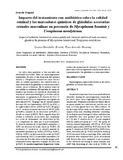| dc.rights.license | http://creativecommons.org/licenses/by-nc-sa/3.0/ve/ | |
| dc.contributor.author | Vivas Acevedo, Giovanny | |
| dc.contributor.author | Lozano Hernández, Ricardo | |
| dc.date.accessioned | 2012-08-23T18:10:11Z | |
| dc.date.available | 2012-08-23T18:10:11Z | |
| dc.date.issued | 2011-12 | |
| dc.identifier.issn | 0543-517-X | |
| dc.identifier.uri | http://www.saber.ula.ve/handle/123456789/35807 | |
| dc.description.abstract | Las infecciones genitales se han asociado con
infertilidad masculina. Entre los microorganismos
responsables de estas se han destacado Mycoplasma
hominis y Ureaplasma urealyticum cuyos efectos
sobre la calidad espermática son controversiales, y
sobre la función de las glándulas accesorias masculinas
existen pocas evidencias. En la primera etapa de
este estudio se evaluaron 300 muestras de semen de
hombres que asistían a la consulta de infertilidad, de
acuerdo al cultivo microbiológico y a la detección de
anticuerpos se agruparon en M. hominis (n=24) y U.
urealyticum (n=18), y se compararon con el grupo sin
infección (n=159). El grupo con M. hominis mostró
descenso del test hiposmótico (HOST) (p<0,05) y
de α-glucosidasa neutra (AGN) (p<0,05). El grupo
con U. urealyticum mostró descenso de HOST, AGN
(p<0,001); aumento de los leucocitos (p<0,001) y
del pH en semen (p<0,05). En la segunda etapa del
estudio se evaluaron los pacientes que cumplieron
tres ciclos de tratamiento con doxiciclina (n=28)
y se compararon los datos pre vs post tratamiento.
Se observó aumento de la movilidad espermática y
AGN con descenso del ácido cítrico (p <0,001). Al
erradicarse U. urealyticum se observó aumento de
movilidad espermática (p <0,001), HOST (p <0,001),
AGN (p <0,001) con descenso de leucocitos (p <0,05)
y pH seminal (p <0,05). La movilidad espermática y la
concentración de ácido cítrico en los dos grupos post-tratamiento fueron superiores al grupo sin infección (p<0,05). Se considera importante diagnosticar y tratar la infección seminal por M. hominis y U. urealyticum
para evitar el efecto negativo de estas bacterias sobre el
espermatozoide y las glándulas accesorias masculinas. | es_VE |
| dc.language.iso | es | es_VE |
| dc.publisher | SABER ULA | es_VE |
| dc.rights | info:eu-repo/semantics/openAccess | |
| dc.subject | Espermograma | es_VE |
| dc.subject | α-glucosidasa neutra | es_VE |
| dc.subject | Ácido cítrico | es_VE |
| dc.subject | Glándulas accesorias masculinas | es_VE |
| dc.title | Impacto del tratamiento con antibiótico sobre la calidad seminal y los marcadores químicos de glándulas accesorias sexuales masculinas en presencia de Mycoplasma hominis y Ureaplasma urealyticum | es_VE |
| dc.title.alternative | Impact of antibiotic treatment on semen quality and chemical markers of male accessory glands in the presence of Mycoplasma hominis and Ureaplasma urealyticum | es_VE |
| dc.type | info:eu-repo/semantics/article | |
| dc.description.abstract1 | Genital infections have been associated with male
infertility. Among the microorganisms responsible
for these have been highlighted Mycoplasma
hominis and Ureaplasma urealyticum whose effects
on sperm quality are controversial, and the role of
male accessory glands have very little evidence. In
the first stage of this study, we evaluated 300 semen
samples from men attending infertility consulting.
According to microbiological culture and detection
of antibodies they were grouped into M. hominis
(n = 24) and U. urealyticum (n = 18), and compared
with the uninfected group (n = 159). The group M.
hominis showed hyposmotic (HOST) (p <0.05) and
neutral α-glucosidase (AGN) (p <0.05) decreased. The
group U. urealyticum HOST and AGN (p <0.001) were
lower; but leukocytes (p <0.001) and pH in semen (p
<0.05) increased. In the second stage of the study data
of patients who completed three cycles of treatment
with doxycycline were compared vs pre-treatment.
It was observed increasing in sperm motility and AGN with decreasing of citric acid (p <0.001). At eradicated U. urealyticum sperm motility (p <0.001),
HOST (p <0.001), AGN (p <0.001) was increased;
with decreasing of leukocytes (p <0.05) and seminal
pH (p <0.05). Sperm motility and concentration of
citric acid in the two groups after treatment were
higher than the group without infection (p <0.05). It
is considered important to diagnose and treat seminal
infection by M. hominis and U. urealyticum to prevent
the negative effect of these bacteria on the sperm and
male accessory glands. | es_VE |
| dc.description.colacion | 13-21 | es_VE |
| dc.description.email | giovanny@ula.ve | es_VE |
| dc.description.frecuencia | semestral | |
| dc.identifier.depositolegal | 195802ME1003 | |
| dc.publisher.pais | Venezuela | es_VE |
| dc.subject.facultad | Facultad de Farmacia y Bioanálisis | es_VE |
| dc.subject.publicacionelectronica | Revista de la Facultad de Farmacia | |
| dc.subject.seccion | Revista de la Facultad de Farmacia: Artículo Original | es_VE |
| dc.subject.thematiccategory | Medicina y Salud | es_VE |
| dc.subject.tipo | Revistas | es_VE |
| dc.type.media | Texto | es_VE |


